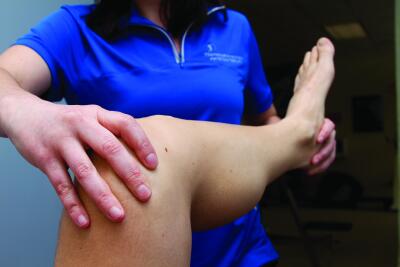Fascia in a Knot? See a PT!
Editor's Note: This post is a collaboration between physical therapist Lindsy and our brand manager Kate!
Lindsy:
“I have always had tight hamstrings. I stretch and foam roll, but they are always tight. I guess I was just made that way.” Is this you? Maybe for you it’s not hamstrings, but insert any other body region and this is a common complaint heard in Physical Therapy. Have you tried stretching, massage, foam rolling, but still feel tension? There may be a type of tissue that has been overlooked: fascia.
Fascia is connective tissue that is found throughout the body. It covers everything from muscles and bones to internal organs. Fascia helps support and hold our body together, but it also is able to stretch and contract. Fascia is very complex and functions as one continuous structure. This means that tightness in your hamstrings could hypothetically start with fascial restrictions in your neck. Crazy!

Fascia can get torn, twisted, knotted, etc. and this can lead to pain and tightness. Think of fascia like plastic wrap around everything. Then imagine that plastic wrap gets twisted or clumped together or torn apart. This is why you can work on muscle tension and still have tightness if that plastic wrap has problems.
So how do we treat fascia? Foam rolling is a good start, but fascia can be very stubborn and may need something more aggressive. More aggressive than foam rolling?!?!? Don’t be too scared; it is a short amount of intense work, but will give you a lot of relief. There are two common ways we treat the fascia at Therapeutic Associates: ASTYM and hands on technique, including a very unique treatment philosophy called the Fascial Distortion Model.
ASTYM™ uses plastic instruments to help stimulate the body to remodel the restricted tissue. We treat the whole body chain related to the problem area; meaning, if your hamstrings are tight, we treat from your hip to down past your knee on the front, back, and sides of your leg. You will also be given exercises to help the tissue remodel the way you need to use it. If we just used the instruments, it would help some, but chances are your tissue would not remodel the way it needs to (so no slacking on exercises!). Find out more about ASTYM here.

Another way we can work on fascia is by using hands on techniques to treat the exact areas where you tell us you have pain. Techniques like myofascial release, Rolfing, and even some deep tissue work can help treat the fascia. However, some of the physical therapists at TAI are trained in another technique called the Fascial Distortion Model. This treatment philosophy relies on watching your hand gestures and listening to your descriptions of symptoms to indicate what is happening with your fascia. The physical therapist then uses their hands to untwist, unknot and close up tears in the fascia. It is really one of those things you have to see to believe and not all PTs have training in this treatment, so check out one of our southwest Washington clinics to see a PT who can do FDM. To learn more about FDM, check out www.afdma.com.
Kate:
More like feel to believe!! I first visited Lindsy at TAI Camas in August after struggling with a nagging injury in my right leg. About halfway through a half marathon in July, I felt a sharp pain in my knee that didn’t subside - I had to walk most of the rest of the race. After suffering through a few weeks of pain, I started to panic - Hood to Coast and the Portland Marathon were coming up fast. I finally admitted I needed help and made an appointment with Lindsy.
We started with talking through my symptoms - I explained where I felt pain and Lindsy had me do a few movements to see how my body moved and where she could identify weakness. She did a quick strength test on each leg and…
Guilty: she immediately called me out on my runner’s butt (you know it - us runners tend to have weak glutes. It’s something we really need to be conscious of working on!) and identified my pain as an issue stemming from my IT Band. We tried FDM to release the fascia in my right leg, especially around my knee. I’m gonna be honest with you: it hurt. A lot. But the payoff was worth it. I iced my knee that night and felt a new lightness and ease of movement the next day - victory!
Not so fast...by a couple days later, the “funkiness” (as I always called it to Lindsy) and pain had returned. Miracles don’t happen in a day, so I made another appointment and we tried ASTYM. Whew, more pain (amazing what PTs can do with just their hands and some plastic tools!). Tons of bruising, daily icing. But this time, it worked!
The combo of ASTYM and FDM (along with the exercises Lindsy assigned me to do daily) worked magic for me. While the “funkiness” has lingered (as I work on my glutes and overall strength - thanks bootcamp! - it improves), the pain is gone. The five minutes of pain for each treatment has been so worth it to be able to run again. I completed Hood to Coast and the Portland Marathon without pain and haven’t looked back!
Let this be a lesson to you all - if you have lingering pain that lasts for two weeks or more, go see a physical therapist! They can help you figure out what’s going on with your body, treat it, and get you back on your feet.
 PAIN IS NOT NORMAL and Lindsy Palisca PT, DPT is an expert physical therapist specializing in pain free living! Treating patients since 2009, she opened Therapeutic Associates Physical Therapy – Camas in 2013, and loves being a part of the SW WA community. Physical Therapy is a powerful tool to treat every client, not just post-operative or sports injury clients. In a perfect world, she would see clients before they had an injury. However, this is not currently the case most of the time, extra time is spent educating patients on their current condition and what they can do to prevent it in the future. She believes that when clients have a care team which includes a Physical Therapist, they respond faster and the results last longer.
PAIN IS NOT NORMAL and Lindsy Palisca PT, DPT is an expert physical therapist specializing in pain free living! Treating patients since 2009, she opened Therapeutic Associates Physical Therapy – Camas in 2013, and loves being a part of the SW WA community. Physical Therapy is a powerful tool to treat every client, not just post-operative or sports injury clients. In a perfect world, she would see clients before they had an injury. However, this is not currently the case most of the time, extra time is spent educating patients on their current condition and what they can do to prevent it in the future. She believes that when clients have a care team which includes a Physical Therapist, they respond faster and the results last longer.
Lindsy is certified in ASTYM™, has additional training in manual therapy through NAIOMT and the Fascial Distortion Model, and is also trained in the specialty areas of running/footwear analysis, vestibular disorders, TMD, and migraines. Lindsy received her Doctorate of Physical Therapy in 2009 from A.T. Still University in Arizona. Prior to this she graduated from Oregon State University in 2005 with a BS in Exercise Sports Science. She began working at TAI in 2011 after returning to the Pacific Northwest with her husband and two dogs. She is also an Adjunct Faculty member at A.T. Still University in the DPT program. In her free time Lindsy enjoys attending sporting events, hiking, traveling, and exploring the Pacific Northwest with family and friends.
Connect With Us
see the latest from Fleet Feet PDX